Servicios Personalizados
Revista
Articulo
Indicadores
-
 Citado por SciELO
Citado por SciELO -
 Accesos
Accesos
Links relacionados
-
 Citado por Google
Citado por Google -
 Similares en
SciELO
Similares en
SciELO -
 Similares en Google
Similares en Google
Compartir
DYNA
versión impresa ISSN 0012-7353versión On-line ISSN 2346-2183
Dyna rev.fac.nac.minas v.77 n.163 Medellín jul./sep. 2010
XPS STRUCTURE ANALYSIS OF TiN/TiC BILAYERS PRODUCED BY PULSED VACUUM ARC DISCHARGE
ANÁLISIS ESTRUCTURAL DE BICAPAS DE TiN/TiC PRODUCIDAS POR DESCARGAS PULSADAS POR ARCO EN VACÍO
ELISABETH RESTREPO PARRA
M.Sc. Física, Grupo de Desarrollo de Nuevos Materiales, Departamento de Física y Química, Universidad Nacional de Colombia - Sede Manizales, erestrepop@unal.edu.co
PEDRO JOSE ARANGO ARANGO
M.Sc. Física, Departamento de Física y Química, Universidad Nacional de Colombia - Sede Manizales
VICENTE JAVIER BENAVIDES PALACIO
M.Sc. Matemáticas, Departamento de Matemáticas y estadística, Universidad Nacional de Colombia - Sede Manizales, vjbenavidesp@unal.edu.co
Received for review October 30th, 2009, accepted March 3th, 2010, final version April, 6th, 2010
ABSTRACT: TiN/TiC Bilayers were grown on 304 stainless steel substrates using physical vapour deposition assisted by pulsed arc plasma system (PAPVD) at two substrate temperatures (50º C and 150º C). X ray photoelectron spectroscopy (XPS) was used to analyze the chemical composition by observing the behaviour of the Ti2p, N1s and C1s lines. Binding energy analysis confirmed TiN and TiC formation. The C1s and Ti2p peaks shifted with increasing XPS sputtering time, thus revealing hydrocarbides contamination. Furthermore, depth profiles of the TiN/TiC bilayers showed that the films grown at a substrate temperature of 150º C had a thicker TiN layer than the samples grown at 50º C. Nitrogen had diffused into the TiC layer and carbon into the TiN layer in both films.
KEYWORDS: PAPVD, XPS, chemical composition, stoichiometry, depth profiles.
RESUMEN: se crecieron bicapas de TiN/TiC sobre sustratos de acero inoxidable 304 usando un sistema de deposición física de vapor asistida por plasma en forma de arco pulsado a dos diferentes temperaturas del sustrato (50º C y150º C). Para el análisis de la composición química se empleó la técnica de la espectroscopía de fotoelectrones de rayos X (XPS). Se observó el comportamiento de las líneas Ti2p, N1s y C1s. Los análisis de energía de enlace confirmaron la conformación de TiN y TiC. Los picos C1s y Ti2p sufrieron un corrimiento a medida que se incrementó el tiempo de esputtering, revelando contaminación debido a la presencia de hidrocarburos. Además, los perfiles de profundidad de las bicapas de TiN/TiC mostraron que las películas crecidas a una temperatura de 150 ° C tienen una capa de TiN más gruesa que las muestras crecidas a 50º C. El nitrógeno se difundió en la capa de TiC y el carbón en la capa de TiN para ambas temperaturas.
PALABRAS CLAVES: PAPVD, XPS, composición química, estequiometria, perfiles de profundidad.
1. INTRODUCTION
Recently research on the characteristics of coatings and the technologies used to produce them has been increased. Moreover, new and refined materials and technologies have been produced better
combinations of film materials with more advanced designs [1]. Some of the most widely used commercial coatings are Al2O3, TiC, TiN, Ti(C,N), Ti(Al,N), DLC deposited by chemical vapor deposition (CVD), and physical vapor deposition (PVD) [2]. Multilayer hard coatings have improved mechanical, chemical and tribological behavior. Furthermore, combining layers with different mechanical properties can improve coatings performance [3]. The greatest possibility offered by multilayer coatings lies in controlling the properties of the individual constituent layers through their chemical composition, and the properties of the whole multi-layer coating through the number of the layers and their thickness [4].
Titanium, one of the most used elements in coatings, has been deposited in monolayer and multilayer coatings. When used as a monolayer, nitrides and carbides such as TiN, TiC, TiAlN, TiCN have been widely used as hard protective coatings due to their excellent tribological properties -wear resistance, friction coefficient-, erosion and oxidation resistance and stability at high temperature, among others [3, 4, 5]. For instance, titanium nitride coatings have been widely employed to harden and protect cutting surfaces in order to improve their lifetime and for decoration because of its metallic gold color [4, 5]. Furthermore, TiN is one the materials most frequently investigated in multilayers (CN/TiN, TiCN/TiN, TiN/TiC, Ti/TiN), where the TiN layer is usually deposited first because it adheres very firmly to different substrates (e.g. HSS, silicon) [6, 7]. Due to brittleness and its poor adherence of TiC layer, most studies concern about TiN/Ti(C,N)/TiC [8-10], but only a few of studies concern about TiN/TiC multilayer system, in spite of TiC has high hardness as protective coating, excellent wear resistance and good stability, its applications are reduced when it is directly grown on steel as substrate [11, 12], making it necessary to apply an intermediate layer TiN as an intermediate layer and has demonstrated good adhesion on steel substrate [13]. The TiN/TiC multilayer coatings can be deposited by plasma-assisted chemical vapor deposition [14], arc ion plating [15], magnetron sputtering [16] and laser ablation [17]. Their wear-resistant properties were improved in comparison to TiN or TiC single layers. However, their insufficient adhesion that is caused by the low process temperature of PVD and by the diffusion of coating metal into the substrate and the grain grown problem that are caused by the thermal process of CVD, restricting their further application [18].
Vacuum arc discharge is a widely used industrial hard coating technique; large droplet-particles are always present in the coatings so that this technique has not been considered suitable for fine coatings such as multilayer films [18]. Never the less in previous research, authors of this work introduced heating of the substrate into the arc technique, reporting that the substrate temperature could also diminish the condensation of micro-droplets on the substrate, helping their destruction [19].
In vacuum arc techniques, a high current electrical discharge is generated by conducting electrodes immersed in a vacuum or in a low pressure chamber. The cathode generates an intense metallic plasma jet with ion kinetic energies ranging from 20-100 eV when a reactive gas such as nitrogen or oxygen is present in the chamber. Oxides, nitrides and carbides can be produced [20-22]. On the other hand it is well known that the deposition parameters produce high influence on mechanical, tribological, chemical and other physical properties of coatings [23-25]. For example, it is well known that the composition, structure, and properties of deposited films are greatly affected by deposition temperature [26]. K. Chu et al [27] reported nitrogen-saturated solid solution titanium-aluminium-nitride (Ti,Al)N thin films grown on Si(100) (for concentration and mechanical analyses), and grown on AISI M42 tool steels (for tribological measurement) deposited onto wafers at room temperature by reactive close-field unbalanced magnetron sputtering in an Ar-N2 gas mixture. The effects of substrate negative bias voltages (Ub) on the mechanical and tribological properties of these films have been studied. Recently, Cerio et al [28] reported that the increase of deposition temperature results in the linear decrease of internal stress in TiN films deposited by ionized physical vapor deposition. I. Zergioti et al [29] presented results of TiN and TiB2 coatings grown by pulsed laser deposition and the substrate temperature ranging from 40 °C to 650 °C , in which their influence in the preferential crystallographic orientation and morphology was observed. Nevertheless, strong rise in substrates temperature can generate large residual stresses [18, 30], and based on our previous work, we decided to heat the substrates at not very high temperatures. We are encouraged to study the influence of low substrate temperature in TiN/TiC bilayers produced by pulsed vacuum arc discharge.
On the other hand, XRD is the most common technique used to study the properties of the materials and the influence of external parameters. It allows the determination of the crystallographic phases and structure present in the films. However, in the case of dual, multiphase coatings or multilayers containing materials with very similar structure such as TiN and TiC, which have close lattice parameters [31], exact determination of the individual phases by XRD can be ambiguous because of overlapping peaks or peak broadening. In addition, minor phases of atomic molecular dimensions constituting the interface between the grains might not be observed in XRD. Consequently, this technique cannot give a complete characterization of the nitride and carbide coatings.
X ray photoelectron spectroscopy (XPS) has been widely used to determine the chemical composition and stoichiometry, because it offers excellent elements selectivity, quantitative character and high surface sensitivity [32]. XPS technique can accurately determine stoichiometry and allows studying the band structure of the transition metal nitrides and carbides that have the ability to exist over a wide range of stoichiometries and have many vacancies in their fcc sublattice [33]. The band-structure calculations for transition metal carbides and nitrides show that non-metal 2s states (at about 11 eV below the Fermi energy level for the carbides and 15 eV below the Fermi energy level for the nitrides) are well separated from the valence-band structure at 5 or 6 eV below the Fermi energy level that results from nonmetal 2p states which are strongly hybridized with metal d states. The density of states (DOS) falls to a minimum corresponding to the competition of the hybridized p-d states having mainly metal d character [34].
Even though there are several reports that present depth profiles of Ti(C, N), TiN, TiC grown by different techniques [35-37], no reports of depth profiles for TiN/TiC bilayers, when they have been grown by the pulsed arc technique, have been submitted. For this reason, we intended to observe diffusion of nitrogen in TiC layer and carbon in TiN layer and compare our results with the existing reports.
The purpose of this paper is to show the capability of X-ray photoelectron spectroscopy for analyzing TiN/TiC bilayers produced by physical vapor deposition pulsed arc discharge (PVD-PAD) technique. The bilayers were grown at substrate temperature of 50 ºC and 150 ºC , identifying the influence of this parameter in the chemical composition and the stoichiometry. Additionally, depth profiles were carried out to study the chemical behavior of the materials as a function of thickness (sputter time).
2. EXPERIMENTAL DETAILS
A PAPVD-PAD (plasma assisted physical vapor deposition pulsed arc discharge) was employed to produce the bilayers. The mayor components of the deposition system included a stainless steel reaction chamber with two electrodes (the anode with the samples and a Ti cathode). The vacuum pressure reached by the system in the process was 10-4 Pa. After that the chamber is filled with nitrogen or methane for producing the TiN or TiC layers, according to the experiment. The discharge was generated by an RLC (R=0.46mW, L=2.3 mH, C=0.54 mF) electric circuit. The capacitor bank was charged to an initial voltage by means of a DC power supply. Then it was connected to the coating production system, being discharged between the electrodes as a critically damped waveform. Because of the system was at low pressure, an initial pulse of high voltage (20 kV) was necessary. It was provided by the trigger. The discharge had a time of 30 ms approximately. Fig. 1 presents a scheme of the equipment. The system was previously described by the authors [19, 38].
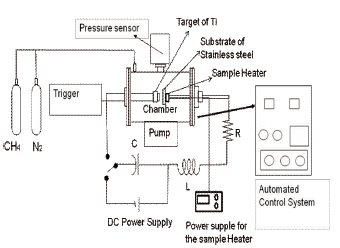
Figure 1. Scheme of the experimental setup employed in the TiN/TiC bilayers production
As substrate, 304 stainless steel was chosen, because some authors report good adherence of TiN and TiC on these materials, due to the formation of metallurgical bonding between coatings and substrate [39]. Samples of 304 stainless steel with 1.3 cm diameter and 2 mm in thickness were employed and the deposition rate was 40 µm/s. They were polished and cleaned using acetone and an ultrasonic method. The layers were produced by using a cylindrical Ti cathode with 5 cm diameter and a purity of 99.9999%. The electrodes were placed face to face with a distance between them of 5 mm. To produce TiN coatings the working gas was nitrogen at a pressure of 250 Pa and a 310 V charge voltage was used. Methane at a pressure of 300 Pa and charge voltage discharge of 270 V was used to grow TiC layers. Two values of substrate temperature were used: 50º C and 150º C.
An XPS ESCALAB 250 Thermo VG Scientific XPS/ISS, with hemispherical analyzer argon ion beam and electron beam with a source of aluminum Ka was used for the chemical analysis. The wide scanning spectral range was between -10 and 1200 eV, with steps of 0.5eV and the step for narrow spectra was 0.1. To produce depth profiles, the samples were bombarded using argon ions with energies between 0.5 to 5 keV. Depth profiles were carried out w during 43200 s (12 h) and narrow spectra were taken each hour. A low-energy electron beam (neutralizer) was used to compensate for charging effects when studying the polymer surface. The binding energy scales were adjusted using the C1s line at 284.6 eV.
For the STM characterization, an Autoprobe CP Park Scientific Instruments with probes of silicon and Software ProScan Image Processing was used. To obtain topographic images of the films, it was used the AFM (Atomic Force Microscopy) mode, employing an ultralever probe of silicon nitride (Si3N4), with a spring constant of 0.16N/m, a scanning speed of 1 HZ, and image resolution of 256 x 256 pixels, in environmental conditions. Using a spring constant of 2.8 N/m it was realized simultaneously AFM.
3. RESULTS AND DISCUSION
Different elements like Ti, C, N and O were observed in the XPS survey spectra. The oxygen was probably associated with contamination produced during the deposition process. Also this contamination could be caused by the environmental contact. Once the spectrum was obtained, Argon ions with an energy of 3 keV and an ion current of 0.5 mA were used to etch the surface for one hour to remove surface contamination. In order to verify the presence of Ti-C and Ti-N bonds, high resolution narrow spectra of Ti, C and N were obtained. The spectral lines were deconvoluted with a combination of Gaussian (70%) and Lorentzian (30%) fits. The peak created by the spin-orbital interaction for Ti2p producing the doublet Ti 2p3/2 and Ti2p1/2 can be observed in fig. 2. The literature reports an energy difference of 6 eV between both peaks of Ti2p [40]. The peaks at 454.7 eV and 460.7 eV correspond to Ti-C [41] and the peaks at 456.3 eV and 462.3 eV correspond to Ti-N [42]. Normally metal macro-particles are presented in arc discharges and they could influence the XPS analysis. Nevertheless, no evidence of metallic Ti2p, which are reported at 453,7 eV and 459,7 eV [43] was found, meaning that possibly these micro-particles are not present in the XPS analysis.
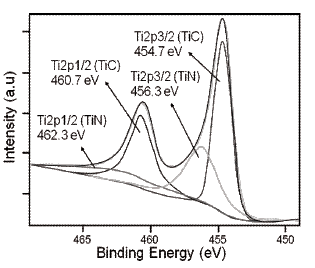
Figure 2. Ti2p XPS spectrum with the peak fitting of the TiN/TiC bilayer grown at 150 ºC on 304 stainless steel substrate
In the case of nitrogen, the narrow spectrum of N1s had a peak in 397.13 eV that corresponds to the Ti-N binding energy, as shown in fig. 3 [44].
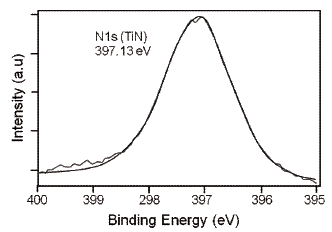
Figure 3. N1s XPS spectrum with the peak fitting of the TiN/TiC bilayer grown at 150 ºC on 304 stainless steel substrate
No other contributions were observed which means that there were no C-N bonds into the material. Similarly, the narrow spectrum of C1s, presented in fig. 4, had two peaks, one at 281.9 eV that corresponds to Ti-C bonds [45] and another at 284.2 eV, corresponding to C-C bonds [46]. There are some reports in the literature about the last peak. Soto [37], X. Ding [47] and Liuhe [48] linked the C-C bonds with the presence of hydrocarbide particles on the film surface.
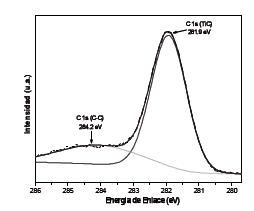
Figure 4. C1s XPS spectrum with the peak fitting of the TiN/TiC bilayer grown at 150 ºC on 304 stainless steel substrate
Possibly they were deposited during the deposition process, because the gas used for growing the TiC films was methane (CH4). This might have occurred because gas was not fully ionized and dissociated, when the plasma was generated. In addition, some carbon at the film surface could come from contamination when the sample was exposed to the environment.
Fig. 5 presents the evolution of the XPS spectrum of C1s after various etching times. The peak at 285.6 eV (C-C) was shifted toward low energies with increasing etching time, 284.6 eV., possibly because the etching removed the surface contamination, which has different hydrocarbide bonds than those in hydrocarbides produced during the coating growth process, and that are present deeper in the film. This has been reported in the literature where surface contamination is frequently presented as thin oxide layers and hydrocarbide type deposits [49].
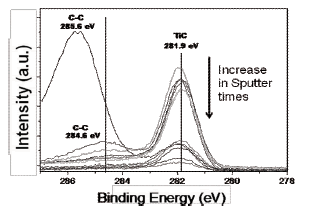
Figure 5. Evolution of the C 1s core level XPS spectra as a function of sputtering times for sample grown at 150 ºC.
For these films, the intensity of the C-C peak decreases much more quickly than it does for the peak at 281.9 eV (Ti-C), supporting the interpretation that a high percent of these bonds are due to contamination. Table 1 shows a summary of the XPS results including the FHWM of each peak.
Table 1 summary of the XPS results for the TiN/TiC bilayers
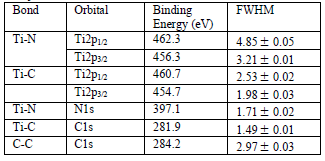
For the N1s peak presented in fig. 6, it was observed that when the etching time increased, the intensity decreased but did not disappear totally which means that nitrogen diffused into the substrate C-N bonds were not found which was favorable since, in this way, the variational structure of the bilayer was not destroyed [48].
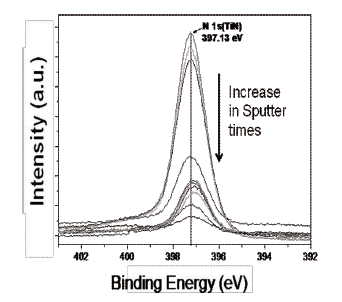
Figure 6. Evolution of the N 1s core level XPS spectra as a function of sputtering times for sample grown at 150 ºC
Several authors have observed no of C-N bond in TiN films. For example Liuhe et al. studied arc deposited Ti(C, N) films using a C2H2/N2 mixture but they observed no C-N bonds [48]. Similarly, Lu and Chen observed no C-N bonds after annealing TiN samples in CO2/H2/N2 mixture [50]. Soto used pulsed laser deposition to prepare titanium-based films in N2 + CH4 and CO + N2 atmospheres [40]. Also he didn´t observe any C-N bonds. He found out that nitrogen saturation passivated Ti, and that CH4 molecules were trapped in the film. Some authors have also observed a peak at a binding energy higher than 402 eV. This peak has been assigned to chemically adsorbed nitrogen and has been interpreted as a fraction of N2 released from the oxidation of TiN [51-52]. On the other hand, no shifting has been observed in N1s peak because the TiN coating is not directly exposed to the environment and the process gas is pure nitrogen. Consequently, contamination is less probably than in the TiC coating.
The Ti2p peak shown in fig. 7 did not significantly decrease when the material was etched. During the etching process the difference of energy between Ti 2p3/2 and Ti2p1/2 was maintained at 6 eV. Nevertheless, both peaks were shifted toward higher energies. This happened because the TiC film, which is the layer in contact with the surface, has lower binding energy than the TiN film which is closer to the substrate.
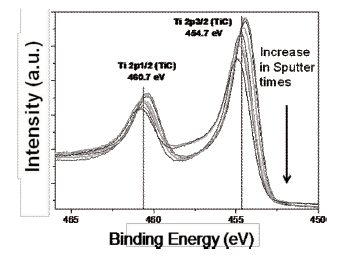
Figure 7. Evolution of the Ti2p core level XPS spectra as a function of sputtering times for sample grown at 150 ºC
One of the most important advantages of the XPS technique is to carry out depth profiles. Depth profiles are presented in fig. 8 and fig. 9 for samples grown at 50 ºC , and 150 ºC. To convert sputtering times into depth, the sputter rate was determined from the known thickness of the layers and from the time needed to reach the interface. The position of the interface is taken as the depth where the overlayer signal has reached 50% of its maximum value. [53]. Fig. 10 shows the thickness of films measured by using SPM technique in AFM mode for coatings produced at 50 C. Fig 10 (a) presents a scan carried out to the TiN film grown after the sample was masked. The thickness obtained was 0.6 + 0.03 µm. Fig 10 (b) shows the AFM scan for the TiN/TiC bilayer, presenting a thickness of 1.2 + 0.07 µm. Results reveal that both TiN and TiC were grown approximately at the same deposition rate. Depth profiles carried out to samples grown at 50 and 150 C have almost the same sputtering time, meaning that the thicknesses are almost similar. Sputtering rate of the XPS analysis is approximately 4 10-5 µm/s. Roughness obtained by AFM images was in the order of 0.055 + 0.03 µm and 0.045 + 0.02 µm for bilayers grown at 50 and 150 C respectively. The profiles carried out by AFM scans presented in fig 7 shows that the coatings do not have high roughness compared with other films grown by similar techniques but without heating the substrate [54, 55]. These profiles are not present high uniformities, as those produced by micro-particles.
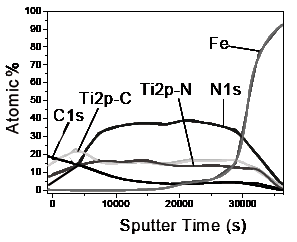
Figure 8. Atomic concentration of Ti, N, C and Fe as a function of sputtering time, for TiN/TiC bilayers grown at 50 ºC
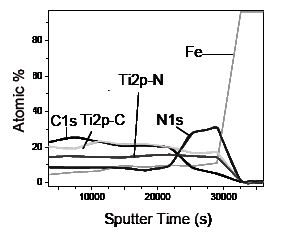
Figure 9. Atomic concentration of Ti, N, C and Fe as a function of sputtering time, for TiN/TiC bilayers grown at 150 ºC
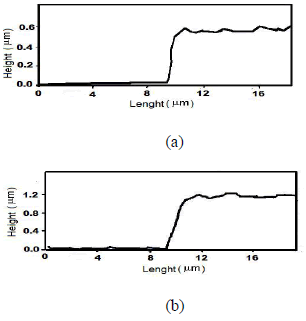
Figure 10. Height profiles produced by using AFM for samples grown at (a) 50 ºC. (b) 150 ºC
Strong diffusion between TiN and TiC was observed, especially for the sample grown at 150º C in fig. 9. This indicate that an increase
in the substrate temperature favors the mobility of C in the TiN structure and N in the TiC structure. Possibly this is because of the film porosity, as reported previously [29].
Y. Lee, showed that it was impossible to identify the interface in dielectric bilayers having high diffusion [51]. Depth profiles with similar characteristics have been reported by Kessler et al in coatings of TiN, TiC and TiCN by CVD. In these works, carbon diffusion formed TiC on TiN at moderate and high temperatures [53]. There is a possibility that the coatings also have defects such as porosity, making diffusion easier. According to the binding energy analysis of the bilayer components, TiCN was no formed.
Table 2 shows the stoichiometry of TiN/TiC grown at substrate temperature of 50 °C and 150 °C. The depth profile was averaged to obtain the atomic percent of each element. The TiC coating produced in this experiment at lower temperature is rich in carbon and TiN coating produced at higher temperature is rich in nitrogen.
Table 2 Stoichiometry of TiN and TiC Coatings

CONCLUSIONS
Ti, C and N were found in TiN/TiC bilayer samples grown at substrate temperatures of 50 ºC and 150 ºC. After one hour of sputtering, XPS peaks corresponding from oxygen and C-C bonds diminished.
XPS peaks corresponding to Ti-N and Ti-C were observed. Also, C-C bonds were found, possibly due to the formation of hydrocarbides attributed to contamination and because the methane gas employed to grow TiC.
Considerable inter-layer diffusion was observed, making it difficult to pinpoint the interface between both TiN and TiC coatings. Increasing substrate temperature favors the mobility of C in the TiN structure and N in the TiC structure. TiC was rich in carbon TiC at 50 °C and TiN rich in nitrogen at 150 °C.
AKNOWLEDGMENTS
The authors gratefully acknowledge the financial support of the División para la Investigación de la Universidad Nacional de Manizales (DIMA). Also, we would like to specially thank professor Alfonso Devia Cubillos (1953-2008) for his technical support.
REFERENCES
[1] VEPREK, S., J. Vac. Sci. Technol. A. The search for novel, superhard materials, Vol. 17 No. 5, 2401-2421, 1999.
[2] PODGORNIK, B., Coated machine elements - fiction or reality? Surf. Coat. Technol Vol. 146-147, 318-323, 2001. [ Links ]
[3] DONOHUE, L. A., CAWLEY, J., LEWIS, D. B., BROOKS, J. S., MUNZ W. D., Investigation of superlattice coatings deposited by a combined steered are evaporation and unbalanced magnetron sputtering technique Surf. Coat. Technol., Vol. 76-77, 149-158, 1995. [ Links ]
[4] TAVARES, C., REBOUTA L., ALMEIDA, B., BESSA J., DA SILVA, M., SOARES, J., Deposition and characterization of multilayered TiN/ZrN coatings Thin Solid Films Vol. 317, 124-128, 1998. [ Links ]
[5] MORI, T., FUKUDA, S., TAKEMURA, Y., Improvement of mechanical properties of Ti/TiN multilayer film deposited by sputtering, Surf. Coat. Technol Vol. 140, 122-127, 2001. [ Links ]
[6] BEMPORAD, E., PECCHIO, C., ROSSI, S. D., CARASSITI, F., Characterization and hardness modeling of alternate TIN/TICN multilayer cathodic arc PVD coating on tool steel Surf Coat Technol Vol. 146-147 363-370, 2001. [ Links ]
[7] MA, K. J., CHAO, C. L., LIU, D. S., CHEN, Y. T., SHIEH, M. B., Friction and wear behaviour of TiN/Au, TiN/MoS2 and TiN/TiCN/a-C:H coatings J. Mater. Process. Technol. Vol. 127 182-186, 2002. [ Links ]
[8] SMOLIK, J., ZDUNEK, K., LARISCH, B., Investigation of adhesion between component layers of a multi-layer coating TiC/Ti(Cx, N1-x)/TiN by the scratch-test method Vacuum Vol. 55, 45-50, 1999. [ Links ]
[9] DING, J., MENG, Y., WEN, S., Mechanical properties and fracture toughness of multilayer hard coatings using nanoindentation ,Thin Solid Films Vol. 371, 178-182, 2000. [ Links ]
[10] JEHN, H. A., Multicomponent and multiphase hard coatings for tribological applications, Surf. Coat. Technol. Vol. 131, 433-440, 2000. [ Links ]
[11] LEVI, G., KAPLAN, W., BAMBERGER, M., Structure refinement of titanium carbonitride (TiCN) Mat. Letters Vol. 35, 344-350, 1998. [ Links ]
[12] MU, H., YU, T., LUO, E., SUNDARAVEL, B, WONG, S., WILSON, I., Ti, TiN, and Ti-TiN thin films prepared by ion beam assisted deposition as diffusion barriers between Cu and Si, Vol 18 No. 5 J. Vac. Sci. Technol A Vol. 18, 2312-2318, 2000. [ Links ]
[13] SMOLIK, J. ZDUNEK, , K., Effect of interlayer composition on the tribological properties of TiC/Ti(Cx,N1-x)/TiN anti-abrasive multi-layer coatings Vacuum Vol. 55, 147-151, 1999. [ Links ]
[14] KIM, D. J., CHO, Y. R., LEE, M. J., HONG, J. M., KIM, Y. K., LEE, K. H., Properties of TiN-TiC multilayer coatings using plasma-assisted chemical vapor deposition Surf Coat Technol Vol. 116-119, 906-910, 1999. [ Links ]
[15] SALAS, O., KEARNS, K., CARRERA, K, S. MOORE, J. J., Tribological behavior of candidate coatings for Al die casting dies ,Surf Coat Technol. Vol. 172, 117-127, 2003. [ Links ]
[16] RADHAKRISHNAN, G., ADAMS, P. M., SPECKMAN, D. M., Low temperature pulsed laser deposition of titanium carbide on bearing steels Thin Solid Films Vol. 358, 131-138, 2000. [ Links ]
[17] WANG, J., LI, W. Z., LI, H. D., Mechanical properties of nanoscaled TiC/Fe multilayers deposited by ion beam sputtering technique Thin Solid Films Vol. 382, 190-194, 2001. [ Links ]
[18] ZHAO, Y., LIN, G., XIAO, J., DONG, Ch., WEN, L., TiN/TiC multilayer films deposited by pulse biased arc ion plating Vacuum, 10.1016/j.vacuum.2009.04.043, In press [ Links ]
[19] DEVIA, A., BENAVIDES, V., RESTREPO, E., ARIAS, D. F., OSPINA, R., Influence substrate temperature on structural properties of TiN/TiC bilayers produced by pulsed arc techniques Vacuum Vol. 81, 378-384, 2006. [ Links ]
[20] SHIAO, M. H., SHIEU, F. S., A formation mechanism for the macroparticles in arc ion-plated TiN films Thin Solid Films Vol. 386, 27-31, 2001. [ Links ]
[21] SANDERS, D. M., BOERCKER, D. B., FALABELLA, S., Coating technology based on the vacuum arc-a review, IEEE Trans. Plasma Sci. Vol. 18 No. 6, 883-894, 1990. [ Links ]
[22] BRUZZONE, H., KELLY, H., MARQUEZ, A., LAMAS, ANSALDI, A., OVIEDO, C., TiN coatings generated with a pulsed plasma arc, Plasma Source Sci. Technol., Vol. 5 No. 3, 582-587, 1996. [ Links ]
[23] S. Moni Borah, A. Ratan Pal, H. Bailung, J. Chutia, Optimization of plasma parameters for high rate deposition of titanium nitride films as protective coating on bell-metal by reactive sputtering in cylindrical magnetron device Appl. Surf. Sci. Vol. 254, 5760-5765, 2008. [ Links ]
[24] NUNES, Y., NWEMANS, A., Wemans, MARQUES, H. P., MARQUES, C., FERREIRA, Q., TEODORO, O. M. N. D., ALVES, E. Alves, MANEIRA, M. J. P., Dual DC magnetron cathode co-deposition of (Al,Ti) and (Al,Ti,N) thin films with controlled depth composition Vacuum 81 1503-1506, 2007 [ Links ]
[25] SANCHEZ-LOPEZ, J. C., MARTINEZ-MARTINEZ, D., LOPEZ-CORTES, C., FERNANDEZ, A., Tribological behaviour of titanium carbide/amorphous carbon nanocomposite coatings: From macro to the micro-scale Surf. Coat. Technol. Vol. 202, 4011-4018, 2008. [ Links ]
[26] CHENG, Y. H., TAY , B. K., LAU, S. P., Influence of deposition temperature on the structure and internal stress of TiN films deposited by filtered cathodic vacuum arc, J. Vac. Sci. Technol. A Vol. 20, No. 4, 1270-1274, 2002. [ Links ]
[27] CHU, K. SHUM, P. W., SHEN, Y. G., Substrate bias effects on mechanical and tribological properties of substitutional solid solution (Ti, Al)N films prepared by reactive magnetron sputtering Mater. Sci. Eng: B Vol. 131, 62-71, 2006. [ Links ]
[28] CERIO, F., DREWERY, J., HUNG, E., REYNOLDS, G., Film properties of Ti/TiN bilayers deposited sequentially by ionized physical vapor deposition, J. Vac. Sci. Technol. A Vol. 16, No. 3, 1863-1865, 1998. [ Links ]
[29] ZERGIOTI, I., HAIDEMENOPOULOS, G. N., FOTAKIS, C., Nanocrystalline growth and diagnostics of TiC and TiB2 hard coatings by pulsed laser deposition, Appl. Phys. A. Matter. Sci. Proc. 69, S427-S431, 1999. [ Links ]
[30] OLBRICH, W., FESSMANN, J., KAMPSCHULTE, G., EBBERINK, J., Improved control of TiN coating properties using cathodic arc evaporation with a pulsed bias Surf. Coat. Technol. Vol. 49, 258-262, 1991. [ Links ]
[31] RESTREPO, E., BENAVIDES, V., DEVIA, A., OLARTE, S., ARROYAVE, M., ARANGO, Y. C., Study of Multilayer Coatings of Ti/TiN/TiC Produced by Pulsed Arc Discharge, Brazilian J. Phys. Vol. 34, 1748-1751, 2004. [ Links ]
[32] BERTOTI, I. , Characterization of nitride coatings by XPS Surf. Coat. Technol. Vol. 151-152, 194-203, 2002. [ Links ]
[33] PORTE, L., ROUX, L., HANUS, J., Vacancy effects in the x-ray photoelectron spectra of TiNx Phys. Rev. B Vol. 28, 3214-3224, 1983. [ Links ]
[34] KLEIN, B., M. PAPACONSTANTOPOULUS, D. A., BOYER, L. L., Mechanisms for energetic-vacancy stabilization: TiO and TiC, Phys. Rev. B. Vol. 22, 991-1006, 1980. [ Links ]
[35] CHENG, Y., ZHENG, Y. F., Characterization of TiN, TiC and TiCN coatings on Ti-50.6 at.% Ni alloy deposited by PIII and deposition technique Surf. Coat. Technol. Vol. 201, 4909-4913, 2007. [ Links ]
[36] TAKAHASHI, M., SHIMADA, S., Preparation of composite and compositionally graded TiC-TiN films by liquid injection plasma-enhanced CVD Solid State Ionics Vol. 172, 249-252, 2004. [ Links ]
[37] VESEL, A., MOZETIC, M., KOVAC, J., ZALAR, A., XPS study of the deposited Ti layer in a magnetron-type sputter ion pump Appl. Surf. Sci. Vol. 253, 2941-2945, 2006. [ Links ]
[38] DEVIA, A., RESTREPO, E., SEGURA, B., ARANGO, Y. C., ARIAS, D., Study of TiN and Ti/TiN coatings produced by pulsed-arc discharge Surf. Coat. Technol. Vol. 190 No. 1, 83-87, 2004. [ Links ]
[39] REN, Y. J., ZENG, C. L., Corrosion protection of 304 stainless steel bipolar plates using TiC films produced by high-energy micro-arc alloying process J. Power Sources Vol. 171, 778782, 2007. [ Links ]
[40] SOTO, G., AES, EELS and XPS characterization of Ti(C, N, O) films prepared by PLD using a Ti target in N2, CH4, O2 and CO as reactive gases Appl. Surf. Sci. Vol. 233, 115-122, 2004. [ Links ]
[41] BENKO, E., BARR, T. L., HARDCASTLE, S., HOPPE, E., BERNASIK, A., MORGIEL, J., XPS study of the cBN-TiC system, Ceramics International, Vol. 27, No. 6, 637-643, 2001. [ Links ]
[42] STRYDOM, I., HOFMANN, S., The contribution of characteristic energy losses in the core-level X-ray photoelectron spectroscopy peaks of TiN and (Ti, Al)N studied by electron energy loss spectroscopy and X-ray photoelectron spectroscopy J. electron spect. Related phenom., Vol. 56, 85-103, 1991. [ Links ]
[43] TREGLIO, J. R., ELKIND, A., STINNER, R. J., PERRY, A. J., Advanced vacuum arc metal ion implantation systems Surf. Coat. Technol. Vol. 96, l-8, 1997. [ Links ]
[44] GEORGIEV, D. G., BAIRD, R. J., NEWAZ, G., AUNER,, G., WITTE, R., HERFURTH, H., An XPS study of laser-fabricated polyimide/titanium interfaces Appl. Surf. Sci. Vol. 236, 71-76, 2004. [ Links ]
[45] JOUAN, P. Y., PEIGNON, M.-C., CARDIAUD, CH. LEMPERIERE, G., Characterisation of TiN coatings and of the TiN/Si interface by X-ray photoelectron spectroscopy and Auger electron spectroscopy Appl. Surf. Sci., Vol. 68, 595-600, 1993. [ Links ]
[46] HAMRIN, K., JOHANSSON, G., FAHLMAN, A., NORDILING, C., Charge transfer in transition metal carbides and related compounds studied by ESCA J. phys. Chem. Solids, Vol. 30, 1835-1847, 1969. [ Links ]
[47] DING, X., TAY, B. K., TAN, H. S., LAU, S. P., CHEUNG, W. Y., WONG, S. P., Preferential orientation of titanium carbide films deposited by a filtered cathodic vacuum arc technique Surf. Coat. Technol. Vol. 138, 301-306, 2001. [ Links ]
[48] LIUHE, L., LIFANG, X., XINXIN, M., XPS of Ti+TiN+(N,C) multilayer films deposited by filtered cathodic arc deposition with controlled feed gas flow rate Surf. Coat. Technol. Vol. 120-121, 618-621, 1999. [ Links ]
[49] BERTOTI, I. , MOHAI, M., RENEVIER, N. M., SZILAGYI, E., XPS investigation of ion beam treated MoS2-Ti composite coatings Surf. Coat. Technol. Vol. 125, 173-178, 2002. [ Links ]
[50] OVIEDO, C., Técnicas de Análisis de Superficies. CNEA. Buenos Aires.1998. [ Links ]
[51] LEE, Y. J., LEE, J. H., LEE, Y. Y., KANG, Y. H., KIM, Y. S., KWON, S. N. JEONG, K., Interdiffusion in vacuum-deposited dielectric thin films, Optics Comunications Vol. 190, 211-220, 2001. [ Links ]
[52] KESSLER, O. H., HOFFMANN, F. T. MAYR, P., Microstructure and property changes caused by diffusion during CVD coating of steels Surf. Coat. Technol. Vol. 120-121, 366-372, 1999. [ Links ]
[53] DUMONTA, J., MONROY, E., MUÑOZ, E., CAUDANO, R., SPORKEN, R., Investigation of metal-GaN and metal-AlGaN contacts by XPS depth profiles and by electrical measurements J. Crystal Growth Vol. 230, 558-563, 2001. [ Links ]
[54] FANG T. -H., JIAN S.-R., CHUU D. -S. Nanomechanical properties of TiC, TiN and TiCN thin films using scanning probe microscopy and nanoindentation, Appl. Surf. Sci. Vol. 228, 365-372, 2004. [ Links ]
[55] MARTIN P. J., NETTLERFIELD R. P., KINDER T.J., DESCOTES L., Deposition of TiN, TiC and TiO2 films by filtered arc evaporation, Surf. Coat. Technol. Vol. 49, 239-243. 1991. [ Links ]














